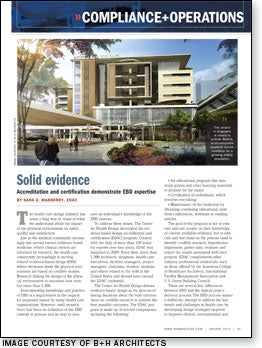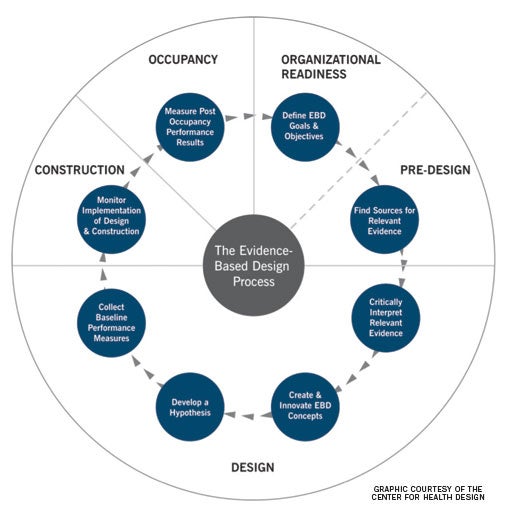Solid evidence
 The health care design industry has come a long way in terms of what we understand about the impact of the physical environment on safety, quality and satisfaction.
The health care design industry has come a long way in terms of what we understand about the impact of the physical environment on safety, quality and satisfaction.
Just as the medical community increasingly has moved toward evidence-based medicine, where clinical choices are informed by research, the health care community increasingly is moving toward evidence-based design (EBD) where decisions about the physical environment are based on credible studies. Research linking the design of the physical environment to outcomes now number more than 1,200.
Demonstrating knowledge and practice of EBD is a requirement in the request for proposals issued by many health care organizations. However, until recently, there had been no definition of the EBD context or process and no way to measure an individual's knowledge of the EBD process.
To address these issues, The Center for Health Design developed the evidence-based design accreditation and certification (EDAC) program. Created with the help of more than 100 industry experts over four years, EDAC was launched in 2009. Since then, more than 1,300 architects, designers, health care executives, facilities managers, project managers, clinicians, vendors, students and others related to the field in the United States and abroad have earned the EDAC credential.
The Center for Health Design defines evidence-based design as the process of basing decisions about the built environment on credible research to achieve the best possible outcomes. The EDAC program is made up of several components, including the following:
- An educational program that uses study guides and other learning materials to prepare for the exam;
- Certification of individuals, which involves test-taking;
- Maintenance of the credential by obtaining continuing educational units from conferences, webinars or reading articles.
The goal of the program is not to educate and test people on their knowledge of current available evidence, but to educate and test them on the process used to identify credible research, hypothesize, implement, gather data, evaluate and report the results associated with their projects. EDAC complements other industry professional credentials, such as those offered by the American College of Healthcare Architects, International Facility Management Association and U.S. Green Building Council.
There are several key differences between EBD and the typical project delivery process. The EBD process makes a deliberate attempt to address the key trends and challenges in health care by developing design strategies targeted to improve clinical, environmental and safety performance. Another key difference is the use of research to educate the project team and guide the development of design strategies to help achieve better outcomes. Finally, once a project is completed, results are gathered and evaluated, and new research is conducted and shared to add to the body of knowledge in the industry.
Additionally, the EBD process complements the Lean process. Lean is about eliminating waste and improving flow and processes that create more value. They are both used with the end objective of creating better design solutions. "An EBD process should incorporate the results learned from using Lean methods," says John Kouletsis, AIA, EDAC, vice president of facilities planning for Kaiser Permanente, Oakland, Calif. "They should be considered symbiotic approaches to achieving better design. The EBD process is one that many professions can use for design and problem solving. The beauty of EDAC is that it made the process available to a wider audience."
Preparing for the exam
The first step in studying for the EDAC exam is to download the candidate handbook from the EDAC website at www.healthdesign.org/edac. It includes the exam content outline, which lists all the domain areas the exam covers.
A set of study guides in Volumes 1–3 also is available. Volume 1 of the Study Guide, which is free, explains the components of the health care delivery system, the trends impacting health care, the various settings in which delivery occurs and the history of EBD. Volume 2 explores the value of using credible evidence in health care projects, and explains how design solutions are empirically evaluated and evidence is generated through research. Volume 3 shows how EBD is applied within the typical design and construction process and how to evaluate results. Candidates also may want to participate in scheduled study sessions offered by EDAC's educational partner Nurture by Steelcase Inc., Grand Rapids, Mich., or those held at conferences. A sample exam and online study sessions also are available.
Once a candidate is ready to take the exam, he or she completes an application through Morrisville, N.C.-based Castle Worldwide Inc. testing services and schedules it at his or her convenience at a number of locations throughout the United States and abroad. The cost to take the exam is $335 at U.S. and Canadian locations and $400 elsewhere. Unless the exam is given on paper in conjunction with a conference, such as the Healthcare Design Conference or the International Summit & Exhibition on Health Facility Planning, Design & Construction, notification of pass or fail is immediate.
There are three types of questions on the exam.
• "Recall" questions mean simply that they require a person to memorize facts (e.g., the definition of EBD or the eight steps of the EBD process). The answers don't vary with the situation.
• "Application" questions require interpretation and recognition of relationships within the question, which will contain one or more variables. These require careful reading and correlation of the answers with the variables.
• "Analysis" questions require problem solving and synthesis to select the best answers. Again, reading the question carefully will help provide clues to selecting the right answer. All the questions on the exam were built using stems (the statement to which the candidate responds), keys (the most appropriate choice) and distractors (the additional three responses available).
Once certified, maintaining the EDAC credential requires earning three continuing education units (CEUs) a year and paying a small administrative fee every two years. EDAC CEUs are offered through the Health Environments Research and Design Journal and various conferences and webinar programs.

Benefits of certification
One of the benefits of EDAC certification is public recognition of expertise. Toward that end, EDAC professionals are listed on The Center for Health Design website and use the EDAC appellation on their business cards and marketing materials.
EDAC certification also assures health care executives that they are getting value-added expertise and confirmation that the individuals are knowledgeable and qualified about EBD and can provide credibility when justifying expenditures associated with design decisions. It also establishes a common base of knowledge and facilitates communication between the design professional and the health care organization's project team when both have obtained the credential. And obtaining CEUs to maintain the credential provides professional development through ongoing education.
"With our goal of bringing safety and innovation into the WellStar Paulding replacement hospital project, our team decided EDAC certification was important to bring a common language and thought," says T. Mark Haney, FACHE, EDAC, president, WellStar Paulding Hospital, Dallas, Ga. "In the end, we had nine team members, including architects, project managers, medical staff president and our senior leadership team, get EDAC certification."
Certification of individuals is still the No. 1 goal of the EDAC program. The Center for Health Design recognizes, however, that simply getting certified isn't enough. It's important for health care and design professionals to put EBD into practice. The mission is to create a community, broaden the knowledge base and grow the evidence that links the design of the physical environment to outcomes. The vision for the EDAC program is a world where all health care environments are created using an EBD process.
To support putting EBD into practice, The Center for Health Design is developing coaching workshops, a journal club, a research repository and other resources. The Center's Pebble Project also offers the opportunity to become involved in a dynamic collaborative of health care organizations, design professionals and industry partners. In addition, many firms have elected to be Champion and Advocate firms — committing to certifying 25 to 30 percent of their health care teams. Becoming EDAC-certified is the first step toward joining this growing community.
Gaining expertise
As the health care industry continues to explore the influence of hospital design on efficiency, safety and satisfaction, professionals with a background in EBD increasingly will be valued.
Sara O. Marberry, EDAC, is a book author, blogger, Tweeter and former executive vice president of The Center for Health Design. She can be reached at sara@saramarberry.com.
| Sidebar - Steps for taking the EDAC exam |
| Health facilities professionals can easily break The Center for Health Design's evidence-based design accreditation and certification (EDAC) process into the following 10 steps:
For more information on becoming certified, go to www.healthdesign.org/edac/certification. |
| Sidebar - About The Center for Health Design |
| The Center for Health Design is a nonprofit organization that engages and supports professionals and organizations in the health care construction and design industry to improve the quality of health care facilities and create new environments for healthy aging. Its forward-thinking members, partners and volunteers come from many fields, including health care, elder care, architecture, interior design, construction, product design, product manufacturing, education and nongovernmental organizations. The Center for Health Design's mission is to transform health care environments for a healthier, safer world through design research, education and advocacy. For more information, go to www.healthdesign.org. |




